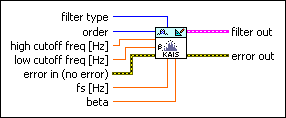DFD Kaiser Design VI
Owning Palette: Advanced FIR Filter Design VIs
Installed With: Digital Filter Design Toolkit
Creates a finite impulse response (FIR) filter by using the Kaiser Window method.
You can use the DFD Kaiser Order Estimation VI to estimate order.

 Place on the block diagram Place on the block diagram |  Find on the Functions palette Find on the Functions palette |
 | filter type specifies the type of filter that this VI creates.
| ||||||||
 | order specifies the filter order. The value of order must be greater than zero. The default is 31. order +1 equals the number of coefficients or filter taps. Increasing the value can narrow the transition band. | ||||||||
 | high cutoff freq specifies the high cutoff frequency in hertz. The value must be greater than low cutoff freq. The default is 0.45. This VI uses this input only for bandpass and bandstop filter design. The cutoff frequency is the frequency with one-half magnitude response. | ||||||||
 | low cutoff freq specifies the low cutoff frequency in hertz. The default is 0.12. The cutoff frequency is the frequency with one-half magnitude response. | ||||||||
 | error in describes error conditions that occur before this VI or function runs.
The default is no error. If an error occurred before this VI or function runs, the VI or function passes the error in value to error out. This VI or function runs normally only if no error occurred before this VI or function runs. If an error occurs while this VI or function runs, it runs normally and sets its own error status in error out. Use the Simple Error Handler or General Error Handler VIs to display the description of the error code. Use error in and error out to check errors and to specify execution order by wiring error out from one node to error in of the next node.
| ||||||||
 | fs specifies the sampling frequency in hertz. The value must be greater than zero. The default is 1, which is the normalized sampling frequency. | ||||||||
 | beta controls the main lobe width and the ratio of the main lobe to secondary lobes. The default is 2.46. If you increase beta while order remains constant, the side lobe decreases in amplitude but the transition bandwidth increases. | ||||||||
 | filter out returns a new filter. | ||||||||
 | error out contains error information. If error in indicates that an error occurred before this VI or function ran, error out contains the same error information. Otherwise, it describes the error status that this VI or function produces.
Right-click the error out front panel indicator and select Explain Error from the shortcut menu for more information about the error.
|
DFD Kaiser Design Details
The Kaiser window is ripple-adjustable, as described by the following equation:

where I0(x) is the zero-order modified Bessel function of the first kind,  is the beta input that controls the main lobe width and the ratio of the main lobe to secondary lobes, and M represents the size of the Kaiser window.
is the beta input that controls the main lobe width and the ratio of the main lobe to secondary lobes, and M represents the size of the Kaiser window.




